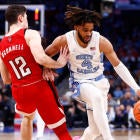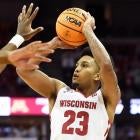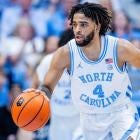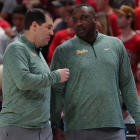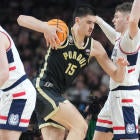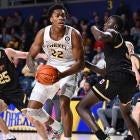
NEW YORK -- Has the Atlantic 10 peaked?
It's no surprise, yet still remarkable, what a year has done to this traditionally proud basketball league. The realignment climate of college sports helped and then almost immediately hurt the stock of the A-10, which twelve months ago entered into a fleeting new era of expectations. With Butler and VCU's inauguration into the conference, those two programs having made three Final Fours in recent years, the 2012-13 forecast had the Atlantic 10 in for a big season. The conference exceeded assumptions. A league-record five teams went to the NCAAs -- with UMass being a legitimate bubble team that didn't break through -- and three more went to the NIT.
La Salle reached the Sweet 16, and in doing so, secured the A-10 the third-most NCAA tournament victories last March, only behind the Big Ten and Big East, which combined to represent 75 percent of the Final Four. By season's end the A-10 finished No. 7 in RPI and No. 8 in KenPom and Sagarin rankings. You could rightfully include it with the former Big Six conferences in college basketball in terms of top-to-bottom strength.
But then the Big East As We Knew It™split apart, birthing the American Athletic Conference out of its abdomen, and so the reformatted Big East plucked Butler from the A-10 after one season -- poaching quintessential A-10 power Xavier from the conference as well. Temple, the premier basketball brand and program in the conference, left the league because football temptations in the American were too sweet.
"Temple is a huge loss. They haven't been considered a mid-major in my lifetime," Richmond coach Chris Mooney said. "I think there are big losses, and obviously gives opportunities to other teams within the conference."
Charlotte jumped ship for football as well, taking its teams to Conference USA. So here's the A-10, 16-deep a year ago and now stocked with 13 teams. George Mason just joined the league, and that's a worthwhile addition. A proud Davidson program will join the ranks of this union in 2014. The A-10 isn't going anywhere or taking a huge dip, but can it be as good this year as it was last year? Can it remain on pace with the five major football conferences, or will we see the A-10 become a member of a second tier in the sport, lumped in with the new Big East, the Mountain West and the American?
"Last year we made an unbelievable statement, compared to when it was (John) Calipari, (John) Chaney, (Mike) Jarvis at GW, it was the best since then," Duquesne's Jim Ferry said. "I'll be quite honest, we probably could have gotten six teams into [the tournament]. We might drop a little bit, but look at VCU: a top-25 team. ... Parity overall in college basketball has changed dramatically with one-and-dones. Teams in our league that keep guys for four years, they can compete with these guys who are one-and-done. You're getting these top-100 recruits and players you've never heard of who are impacts as seniors. It makes it special and competitive."
Ferry alludes to why this has become such a unique league. The teams are good-to-very-good despite a conspicuous lack of NBA talent. Last summer saw the A-10 not have a player picked in the draft for the first time since 2008. The conference has sent just 10 players in nine years to the Association via the draft -- and none have been lottery picks. The last time that happened was URI's Lamar Odom in 1999, who was taken fourth by the Clippers. It should be more of the same for the year ahead; DraftExpress.com only lists VCU's Juvonte Reddic among the top 100 prospects for the 2014 draft.
But should that matter? It probably hurts on the recruiting trail, but again, the A-10 was awesome last year without one player getting picked the following June. How does that happen? It's an interesting combination. The Atlantic 10 has nestled itself into this sector where it can build programs and rely on juniors and seniors -- yet at the same time those players are three- or four-star guys coming out of high school, and in a lot of cases they'll end up playing pro overseas. Many programs in this league can offer recruits 1,000-2,000 minutes of playing time in college before letting them make a career overseas. So the A-10 has built many teams with three, four or five guys every season on the floor who are good enough to play at least a half-decade in Europe.
"It's underrated. It's been underrated since I've been [at Dayton]," Archie Miller said. "There's a lot of guys on a lot of teams that can play heavy roles anywhere win the country. There's really legitimate, high-level players who come into the league. The last couple of seasons, with success in the NCAA, in some cases guys are a little older."
And it's not as if the A-10 is playing with underachieving guys who can't cut it at the pro level. Consider Mason coach Paul Hewitt, who will have all five starters back this season. Hewitt's sent a big batch of players to the pros during his time at Georgia Tech. He knows talent and has lured it. After Mason moved up from the Colonial to the A-10, Hewitt said there was an immediate need to upgrade what players he was courting.
"I said, 'Oof, we've gotta refocus here,' " he said. "The biggest thing in recruiting, other than telling them they can get them to the NBA, is getting to the NCAA tournament, and the A-10 provides that. This is something that can snowball."
The Atlantic 10's primary selling point is teams it puts in the RPI top 100. It targets 10 per year, basically, and when that happens, intra-league play doesn't dampen at-large profiles. What the league has lacked in star power it's made up for in rebuilding how its programs have played the game. VCU, UMass, Saint Louis, La Salle are teams that throw oddball styles of play and lineups at you. In that respect, the league is a throwback.
"Look at this particular year, I would compare George Mason on the court to any of the teams we lost," La Salle coach John Giannini said. "Coaches on the brink of the top 100 last year ... hey're gonna cross that line. This league has a history of losing teams and still improving. We had ten [teams] in [RPI] top 100. Only Big East had more."
And now the Big East as it was is no more. The A-10 has always been a basketball lover's league. It sells itself on being the best basketball-driven conference (that is say: no football involved) in the country. Now there's a challenge for that title with the refurbished Big East. But while that league will still boast star power, the Atlantic 10 will seek to send at least four teams back to the NCAA tournament using a formula that can only really exist within this conference.














